Toshima
Toshima (豊島区, Toshima-ku) is a special ward in Tokyo, Japan. It is one of the eight central wards of the Tokyo Metropolitan area. Located in the northern area of Tokyo, Toshima is bordered by the wards of Nerima, Itabashi, and Kita in the north, and Nakano, Shinjuku and Bunkyo in the south.
Toshima 豊島区 | |
|---|---|
| Toshima City | |
 Ikebukuro at night in Toshima | |
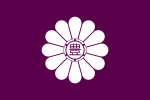 Flag 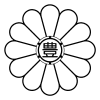 Emblem | |
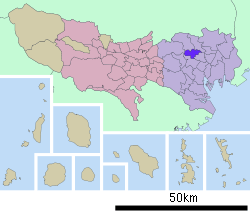 Location of Toshima in Tokyo | |
 Toshima Location in Japan | |
| Coordinates: 35°44′00″N 139°43′00″E | |
| Country | Japan |
| Region | Kantō |
| Prefecture | Tokyo |
| Government | |
| • Mayor | Yukio Takano |
| Area | |
| • Total | 13.01 km2 (5.02 sq mi) |
| Population (May 1, 2015) | |
| • Total | 298,250 |
| • Density | 22,920/km2 (59,400/sq mi) |
| Symbols | |
| • Tree | Prunus × yedoensis |
| • Flower | Azalea |
| Time zone | UTC+9 (JST) |
| City hall address | 1-18-1 Higashi Ikebukuro 170-8422 |
| Website | www |
The ward was founded on March 15, 1947, and reached a peak resident population of 370,000 in 1965. The population has continued to decline and as of May 1, 2015, the ward had an estimated population of 298,250, with a population density of 22,920 persons per km². During the day the population swells with commuters, resulting in a daytime population of around 378,475.
The total land area of Toshima is 13.01 km², sitting on a moderate plateau with a difference of 28 m between the ward's highest and lowest points. Approximately 47% of Toshima's land is residential, and 20% is commercial and public areas.
Although Toshima is a ward, it is referred to as a city. The ward offices are located in Ikebukuro, which is also the commercial and entertainment center of Toshima.
With a non-Japanese population of 19,868, or 7.42% of the total, Toshima is one of the most international wards in Tokyo. Of the foreign population, 56% is of Chinese descent, 20% is of Korean descent, with the rest being of primarily Filipino and European descent.
History
Toshima was formed in 1932 by the merger of four towns, Sugamochō, Nishi-sugamochō, Takadachō, and Nagasakichō, bordered by the quickly expanding former city of Tokyo.
The area evolved from a suburban agricultural district in the Edo period to the urban commercial center that it is today. The growth was fueled by the construction of various rail lines built in the Meiji and Taishō periods.
The former Somei village, now part of Toshima, was a center of plant nurseries, and is the birthplace of the Somei Yoshino, Japan's most popular variety of sakura (cherry blossom tree). The variety was developed at the end of the Edo period.
Politics and government

Toshima is run by a city assembly of 36 elected members. The current mayor is Yukio Takano, an independent backed by all major parties except the Japanese Communist Party.
In April 2011, Taiga Ishikawa was elected to the Toshima assembly, becoming the first openly gay man to win an election in Japanese history.[1]
Districts and neighborhoods
|
|
|
Notes:
- a - 4, 5-chōme
- b - 4-chōme
- c - 2, 3-chōme
- d - 4-chōme
- e - 1-chōme
- f - 3-chōme
- g - 1, 3-chōme
- h - 1-chōme
- i - 1, 2-chōme
- j - 1, 2, 3-chōme
- k - 2, 3, 4-chōme
- l - 2-chōme
Sights

- Sunshine City: The focal point of much of the entertainment in and around Ikebukuro, Sunshine City sports some of the best shopping and dining in Toshima.
- The Ancient Orient Museum
- Morikazu Kumagai Art Museum
- Zoshigaya Missionary Museum
- Toyota Amlux Showroom building is located here
- Tokiwa-sō, an apartment complex famous for being the early living-quarters of many prominent manga artists.
- Tokyo Metropolitan Theatre: Near Ikebukuro Station, this facility built in 1990 is one of the newer spots in Toshima and has a concert hall with regular performances and art exhibitions. There is a stage in the open space out front and it is a popular place for amateur musicians during the warmer months.
- Myonichikan of Jiyu Gakuen Girls' School: Designed by famous American architect Frank Lloyd Wright, this notable building was completed in 1922, shortly before he completed work on the Imperial Hotel.
- Sugamo Jizodori: The shopping district known as "old ladies' Harajuku."
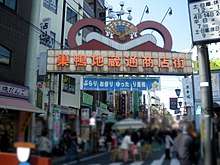
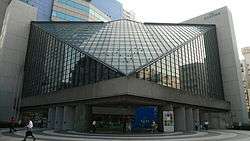
Festivals
- Fukuro Matsuri: This festival started in 1968 and features a parade of mikoshi (portable shrines) and a yassa dance. It is held on September 14 and 15 of each year outside the west exit of Ikebukuro Station and attracts as many as 200,000 people.
- Otsuka Awa Odori Dance: A large summer event gathering 150,000 people, this festival features groups performing and competing with colorful costumes and dancing in front of JR Ōtsuka Station.
- Nagasaki Shishimai (lion dance): The lion dance is performed every year on the second Sunday of May at Nagasaki Shrine.
Economy
FamilyMart has its headquarters in Ikebukuro, Toshima.[2] Seiyu Group has its registered head office in Toshima.[3] Libro, a bookstore chain, is headquartered in Toshima. Itochu corporation and Seven & I Holdings Co., Ltd. has a presence in Toshima.[4] Taisho Pharmaceutical, a pharmaceutical company, also has its headquarters in the ward.[5]
In 1956, Asatsu Inc. established its headquarters in Mejiro, Toshima. In May 1967, the company's headquarters moved to Shinbashi, Minato.[6]
Education
There are five Universities in Toshima.
- Gakushuin University
- Tokyo College of Music
- Rikkyo University or St. Paul's University
- Taisho University
- Tokyo University of Social Welfare
Two prestigious universities are located bordering Toshima. They are University of Tokyo in Bunkyo and Waseda University bordering Shinjuku. Located Tokyo Metropolitan Government Board of Education operates area public high schools.
Toshima is also home to a number of accredited private schools:
Transportation
Rail
The main hub for rail transportation in Toshima ward is Ikebukuro Station, the second busiest train station in Japan.
The rail lines which run through or terminate in Toshima are:
- East Japan Railway Company (JR East)
- Saikyō Line
- Shōnan-Shinjuku Line
- Yamanote Line
- Seibu Railway
- Tobu Railway
- Tokyo Metropolitan Bureau of Transportation (Toei)
- Tokyo Sakura Tram Also known as the Arakawa Metropolitan Streetcar Line, it is Tokyo's only remaining Tokyo Toden streetcar system.
- Toei Subway:
- Tokyo Metro
Famous people
- Tatsuro Yamashita, singer-songwriter and record producer
- Kō Shibasaki, singer and actress
- Jun Matsumoto, singer, actor, and member of Arashi
See also
References
- Natsuko Fukue (April 26, 2011). "First openly gay candidate wins in Tokyo ward". The Japan Times.
- "Company Information Archived 2010-01-29 at the Wayback Machine." FamilyMart. Retrieved on April 7, 2010.
- "Corporate Data Archived 2008-04-18 at the Wayback Machine." Seiyu Group. Retrieved on May 19, 2009.
- "会社案内 Archived 2009-02-23 at the Wayback Machine." Libro. Retrieved on May 19, 2009.
- "Corporate Data." Taisho Pharmaceutical. Retrieved on March 6, 2019.
- "Corporate Overview Archived 2009-12-07 at the Wayback Machine." Asatsu-DK. Retrieved on November 9, 2009.
External links
| Wikimedia Commons has media related to Toshima, Tokyo. |
| Wikivoyage has a travel guide for Toshima. |
- Toshima City Official Website (in Japanese)